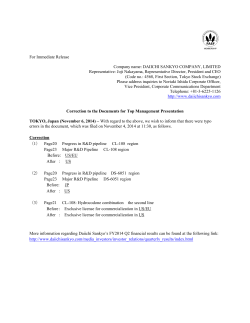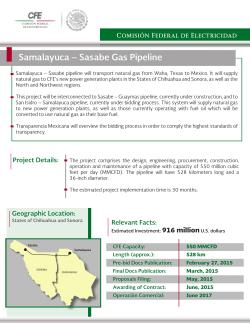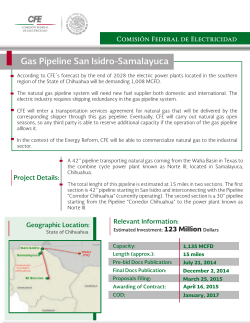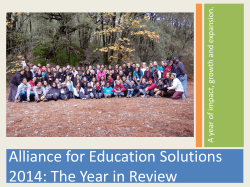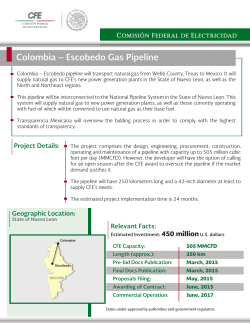
full newsletter PDF - Atlantic Sunrise Pipeline Project
Atlantic Sunrise Project www.williams.com/atlanticsunrise Spring 2015 Williams Files Application Seeking Federal Approval for Pipeline Expansion W illiams has filed a certificate application with the Federal Energy Regulatory Commission (FERC) seeking authorization to expand the existing Transco transmission pipeline to connect natural gas producing regions in northern Pennsylvania to markets in the MidAtlantic and southeastern states by 2017. We are providing this newsletter to parties who may be affected or have an interest in the pipeline proposal. The Atlantic Sunrise project is an expansion of the existing Transco natural gas pipeline, which currently transports about 10 percent of the nation’s natural gas. The project would add about 180 miles of new pipeline to expand and extend the reach of the existing Transco pipeline to Susquehanna County, Pa., transporting about 1.7 billion cubic feet of natural gas per day – enough to serve approximately seven million homes. Inside This Newsletter Exceeding Safety Standards.....................Page 2 Anatomy of a Certificate Application.......Page 3 FAQ............................................................Page 4 Project: $1.6 Billion Economic Impact....Page 5 The project would also include two new pipeline segments (loops) located along the existing Transco pipeline in Pennsylvania which total about 12 miles (Chapman Loop and Unity Loop), two and a half miles of existing pipeline replacement in Virginia, two new compressor facilities in Pennsylvania and other facility additions or modifications in four other states (Maryland, Virginia, North Carolina and Georgia). The certificate application recently filed with FERC is a comprehensive document that describes the proposed project, its need and potential environmental impacts. Since last spring the company has been involved in the FERC pre-filing process, soliciting input from citizens, governmental entities and other interested parties to identify and address issues with potential facility locations. The proposal filed with FERC reflects adjustments to nearly half of the original pipeline alignment introduced during public meetings last spring. These adjustments were a result of feedback received from agencies, communities and other interested parties. Additional route adjustments may still be adopted as the company continues to dialogue with agencies, landowners and other stakeholders. ATLANTIC SUNRISE BY THE NUMBERS 47% Percent of route that has changed since last year 100+ Number of incorporated route changes as a result of stakeholder feedback 11 Months spent in pre-filing process, gathering data & soliciting input from stakeholders 7 Million homes that could be served by natural gas transported by the project Among other things, the certificate application contains a description of the new facilities, detailed maps, schedules, and various environmental reports which detail the studies and analyses that have been conducted. This information helps determine what effect construction and operation of the pipeline could potentially have on the environment and community. Continued on page 2. Williams Files Application Seeking Federal Approval for Pipeline Expansion Continued from page 1. The FERC application also contains various environmental resource reports, which include an analysis of route alternatives, water resources, vegetation and wildlife, cultural resources, socioeconomics, soils, geology and land use. Within the next few months, the FERC will submit a preliminary draft of its Environmental Impact Statement (EIS) to all cooperating state and federal agencies. The draft EIS will describe the proposed facilities and construction methods, identify environmental resources and potential impacts, and evaluate proposed mitigation. It will also identify and evaluate alternatives, analyze impacts on public safety, and recommend additional mitigation and/or conservation measures to further reduce impacts on the affected environment. The draft EIS will be issued for public comment, which may include additional meetings in the project area to gather public feedback. Protecting the Pipe: Exceeding Industry Safety Standards As the Atlantic Sunrise project is designed, constructed and operated, Williams is committed to maintaining the highest standards of safety, utilizing construction and operational procedures that exceed already stringent industry regulations. Once operational, the new pipeline will be maintained and operated according to procedures outlined in the company’s Pipeline Integrity Management Program. These procedures, many of which exceed minimum federal industry regulations, include monitoring of the pipeline 24 hours a day, 7 days a week. The Transco natural gas pipeline has operated pipelines safely in Pennsylvania for decades. For the Central Penn Line, we will demonstrate our commitment to safety by exceeding federal regulations in a number of critical areas, including: yyThe pipe material will meet and generally will exceed the industry requirements; yyUse a higher design factor for all fabricated mainline valve assemblies; yyThicker steel pipe (Class 2) will be installed in less populated locations in order to increase the safety factor; yy100% nondestructive inspection of mainline welds (for example 49 CFR 192 requires only 10% of the 2 welds to the be tested in less populated locations); yyProviding additional cover depth at certain locations (36 inches in Class 1 locations where only 30 inches of cover is required; 60 inches of cover under ditches of all public roads and railroad crossings where only 36 inches is required); and yyPrior to placing the line into service, the pipe will be hydrostatically tested at a maximum pressure that will exceed industry standards identified in 49 CFR 192 (1.5 times the maximum allowable operating pressure). Anatomy of an Application for a Certificate of Public Convenience and Necessity environment. This section also makes the case that the public benefits of the project outweigh potential adverse effects. The siting and construction of interstate natural gas pipelines is regulated by the Federal Energy Regulatory Commission (FERC). An integral component to FERC’s review of a proposed project is the Application for a Certificate of Public Convenience and Necessity (Certificate Application). The Certificate Application is a comprehensive document that describes the proposed project, its need and potential environmental impacts. We recently filed our Certificate Application with FERC for its Atlantic Sunrise project. You can view the application online at www.ferc.gov. Just search for Docket Number CP15-138. The application includes the following information: Description of Proposed Facilities A description of the new pipeline facilities and an overview of their location and cost. Market Support Identification of the customers who have executed contracts to be part of the project, as well as the gas volumes that they have requested. Tariff Description of the proposed rates that project customers will pay for the gas service. Public Convenience and Necessity Included is a description of the company’s efforts to minimize or eliminate potential adverse effects, including impacts to customers, landowners and the of facilities that are considered Critical Energy Infrastructure Information (CEII). Those materials are not available electronically. We anticipate that once the Certificate Application is filed, the FERC will require an additional eight to 10 months to make a final decision on whether to issue a Certificate Order authorizing construction of the pipeline. If authorized, the Certificate Order Other Exhibits will detail the conditions of the approval, Included in the Certificate Application are including the final route that FERC has many exhibits that support the proposal. authorized, and construction and mitigation measures that we must follow. These exhibits include detailed maps, market and cost data, as well as all the Viewing the Application various environmental reports. Exhibit F-1 contains the Environmental Resource A copy of Williams’ Atlantic Sunrise Reports that detail the various studies and project application recently submitted analyses which have been conducted to to FERC is available on FERC’s website determine what effect construction and at www.ferc.gov (select the “Documents and Filing” tab, then “e-library” and then operation could potentially have on the “General Search”). In addition, copies of environment and community and how the application are accessible for public those effects can be effectively minimized inspection at the following public libraries. or eliminated. Timing for Approval The requested in-service date, as well as the date in which the company would like to receive approval of the application. The Environmental Resource Reports include an analysis of route alternatives, as well as an analysis of potential impacts to water resources including wetlands and groundwater, vegetation and wildlife including threatened and endangered species, cultural resources, socioeconomics, soils, geology, land use including proposed developments and, noise and air quality, alternatives, and safety. Following the end of the scoping period, we filed Draft Environmental Resource Reports with the FERC. When the Certificate Application is filed and a Certificate Proceeding (CP) docket number is assigned, a copy of the entire application will be made available for viewing at public libraries, as well as via the FERC website by referencing the project’s docket number (CP15-138). Please note that the application will contain detailed drawings and schematics • Clinton County – Renovo Area Library, 317 7th St., Renovo, Pa. • Columbia County – Bloomsburg Public Library, 225 Market St., Bloomsburg, Pa. • Northumberland County – Shamokin-Coal Township Public Library, 210 E. Independence St., Shamokin, Pa. • Lancaster County – Columbia Public Library, 24 S. 6th St., Columbia, Pa. • Lebanon County – Annville Free Library, 216 E. Main St., Annville, Pa. • Luzerne County – Back Mountain Library, 96 Huntsville Rd., Dallas, Pa. • Lycoming County – James V. Brown Library, 4298 Pennsylvania 42, Unityville, Pa. • Schuylkill County – Tri Valley Public Library, 633 E. Main St., Hegins, Pa. • Susquehanna County – Montrose Main Library, 18 Monument St., Montrose, Pa. • Wyoming County – Tunkhannock Public Library, 220 W. Tioga St., Tunkhannock, Pa. • Prince William County – Bull Run Regional Library, 8051 Ashton Ave., Manassas, Va. • Howard County – Howard County Library, 9421 Frederick Rd., Ellicott City, Md. 3 Frequently Asked Questions: Atlantic Sunrise Project Is the route now considered final? The route filed with FERC in the 7(c) Certificate Application reflects the current preferred alignment incorporating data, comments and input received through Dec. 1, 2014. As additional data is gathered the preferred route may still be adjusted after filing the 7(c) application with FERC. Alternatives that have been and are being considered for the project were filed with FERC as part of the 7(c) application. How much of the route has changed since last spring? The route identification process is fluid and has changed as a result of input from landowners and other stakeholders. As of the FERC filing, nearly half of the Central Penn Line had been altered as a direct result of stakeholder feedback. This includes more than 57% for CPL South and 21% for CPL North based on input from landowners, agencies, municipalities etc. Existing Transco pipeline easement in Pennsylvania We intend to avoid cemeteries of any age, ethnic affiliation, or type. If we are made aware of a cemetery, we will revise the route accordingly to avoid all cemeteries, either Euro-American or Native American. What is an easement? An easement is a limited right to use the land for specific purposes. It does not transfer ownership of the property. When purchasing an easement, we compensate the landowner for the right to construct, Are you crossing Conestoga Indian Town? operate and maintain the pipeline. We intend to avoid both Conestoga Indian How will the value of the easement Town and the hill presumed to be the be determined? final resting place of Chief Civility. We are The valuation of the easement is very aware that Conestoga Indian Town determined by the market value of land is a sensitive area and we understand the in the area as determined by independent importance of proceeding cautiously to sources. These sources can be county thoroughly gather information to ensure deed and tax records, local appraisers, we avoid cultural resource impacts. In real estate brokers and other real estate fact, we have discussed the location in professionals. Factors considered detail with local experts from Millersville generally include length, width, existing University and the Conestoga Area land use and comparable land sales in Historical Society to ensure we have a the area. comprehensive understanding of cultural In addition to the value of the easement, significance and known resources in the landowner is compensated for any the area. actual damages to their property during 4 construction. Such damages may include loss of crop, timber, pasture, or landscape features (or landscape use). Settlement of damages may occur before or after pipeline construction. Damage to fences, gates, roads, drainages, etc., will be repaired prior to the contractor leaving the site. The landowner will be asked to acknowledge completion of and satisfaction with the restoration activities. Can I still farm the land after the pipeline is installed? Yes. After construction of the pipeline, most uses of the surface of the land will be allowed, including farming activities such as crop production or raising livestock. Two notable exceptions include planting trees within the easement or placing a permanent structure within the easement, both of which are prohibited. Penn State Study: Atlantic Sunrise Project Expected to Generate $1.6 Billion Economic Impact The design and construction of the Atlantic Sunrise natural gas pipeline project will generate approximately $1.6 billion in additional wages, revenues and investments to the regional and state economies of Pennsylvania and Virginia, according to a study authored by researchers at Pennsylvania State University. “Economic Impacts of the Atlantic Sunrise Pipeline Project,” lead author Seth Blumsack Associate Professor of Energy Policy at Penn State, finds that the proposed project would have a major, positive economic impact on the Pennsylvania and Virginia economies where new pipeline facilities would be built and operated. According to the researchers, the design and construction of the Williams Atlantic Sunrise pipeline project could support approximately 8,000 jobs and an associated $870 million in economic value added during the construction period. Additionally, the ongoing operation of the pipeline would generate approximately $1.9 million in annual economic impact, supporting 29 jobs. Mid-Atlantic regions could have saved $2.6 billion from 2012–2014 due to increased access to lower-priced Pennsylvania gas supply because of Atlantic Sunrise. Key findings from the analysis include: yyThe majority of the direct expenditures will be in Pennsylvania, with some materials and labor sourced from other states. yyThe multiyear construction phase of the project is expected to result in overall economic impact of $1.6 billion and could engage 8,270 workers in Pennsylvania and Virginia; the 10-county Pennsylvania region of the project is expected to recognize the majority of this impact. yyThe ongoing operations of the project are predicted to generate an annual economic impact of $1.96 million and support 29 direct and indirect jobs in two Pennsylvania counties (Columbia and Wyoming) where two new Greenfield compressor facilities are proposed. yySignificant federal, state and local taxes would also be generated during the approximate one-year construction phase, including an estimated $31 million in federal taxes and $18 million in state taxes across all county locations hosting construction activity for the project. The complete economic impact analysis is available at www.williams.com/ atlanticsunrise. The site contains an economic impact tool that calculates economic impacts at each local level. The economic modeling exercise was funded by Williams and uses IMPLAN, a widely used commercial software designed to perform input-output economic analysis, to estimate impacts on workforce demands, economic output and value added to each of the counties where construction is expected to occur. IMPLAN is used by state governments across the nation for economic modeling and predicting. In a related report titled “Estimating the Impact of the Atlantic Sunrise Project on Natural Gas Consumers,” lead author Andrew Kleit, Professor of Energy and Environmental Economics at Penn State, found that consumers served by the Transco pipeline in the southeast and 5 Williams – Transco 300 Laird Avenue, Suite 200 Wilkes Barre, PA 18702 Connect with us! /AtlSunProject /WilliamsAtlanticSun +Atlanticsunriseexpansion /Atlanticsunriseexpansion For More Information Preliminary Project Schedule Project website: www.williams.com/atlanticsunrise Spring 2014 – Field surveys begin Toll-free information line: 844-785-0455 Spring 2014 – FERC pre-filing process begins E-mail: atlanticsunrise@williams.com Late Spring 2014 – Open houses and informational meetings Land Department: Summer 2014 – FERC scoping meetings Williams – Transco 300 Laird Avenue, Suite 200 Wilkes Barre, PA 18702 Fall 2014 – Submit draft resource reports to FERC Williams – Transco 303 Schoolhouse Road Mahoning Township Danville, PA 17821 March 2015 – Submit 7(c) application to FERC Summer 2016 – Anticipated construction start July 2017 – Target in-service Williams – Transco 2578 Interstate Drive Harrisburg, PA 17110 © 2015 The Williams Companies, Inc. All rights reserved.
© Copyright 2025


